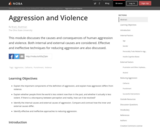
Text and links to all ancillary materials for Module 54
- Subject:
- Psychology
- Social and Behavioral Sciences
- Material Type:
- Module
- Reading
- Teaching/Learning Strategy
- Author:
- Brad J
- Date Added:
- 05/31/2021

Text and links to all ancillary materials for Module 54

By Brad J. Bushman, The Ohio State University. This module discusses the causes and consequences of human aggression and violence. Both internal and external causes are considered. Effective and ineffective techniques for reducing aggression are also discussed.
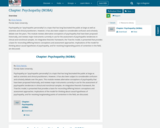
By Chris Patrick, Florida State University. Psychopathy (or “psychopathic personality”) is a topic that has long fascinated the public at large as well as scientists and clinical practitioners. However, it has also been subject to considerable confusion and scholarly debate over the years. This module reviews alternative conceptions of psychopathy that have been proposed historically, and reviews major instruments currently in use for the assessment of psychopathic tendencies in clinical and nonclinical samples. An integrative theoretic framework, the Triarchic model, is presented that provides a basis for reconciling differing historic conceptions and assessment approaches. Implications of the model for thinking about causal hypotheses of psychopathy, and for resolving longstanding points of contention in the field, are discussed.

This course's aims are two-fold: 1) to offer students the theoretical and practical tools to understand how and why cities become torn by ethnic, religious, racial, nationalist, and/or other forms of identity that end up leading to conflict, violence, inequality, and social injustice; and 2) to use this knowledge and insight in the search for solutions. As preparation, students will be required to become familiar with social and political theories of the city and the nation and their relationship to each other. They also will focus on the ways that racial, ethnic, religious, nationalist or other identities grow and manifest themselves in cities or other territorial levels of determination (including the regional or transnational). In the search for remedies, students will be encouraged to consider a variety of policymaking or design points of entry, ranging from the political- institutional (e.g. forms of democratic participation and citizenship) to spatial, infrastructural, and technological interventions.

Global Womens Issues and the Beijing Platform for Action. This book is based on the 12 critical areas of concern identified at the Beijing Conference: 1 The persistent and increasing burden of poverty on women 2 Inequalities and inadequacies in and unequal access to education and training 3 Inequalities and inadequacies in and unequal access to health care and related services 4 Violence against women 5 The effects of armed or other kinds of conflict on women, including those living under foreign occupation 6 Inequality in economic structures and policies, in all forms of productive activities and in access to resources 7 Inequality between men and women in the sharing of power and decision- making at all levels 8 Insufficient mechanisms at all levels to promote the advancement of women 9 Lack of respect for and inadequate promotion and protection of the human rights of women 10 Stereotyping of women and inequality in womens access to and participation in all communication systems, especially in the media 11 Gender inequalities in the management of natural resources and in the safeguarding of the environment 12 Persistent discrimination against and violation of the rights of the girl child
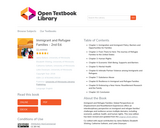
Immigrant and Refugee Families: Global Perspectives on Displacement and Resettlement Experiences uses a family systems lens to discuss challenges and strengths of immigrant and refugee families in the United States. Chapters address immigration policy, human rights issues, economic stress, mental health and traumatic stress, domestic violence, substance abuse, family resilience, and methods of integration.
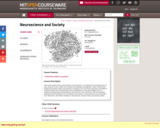
This course explores the social relevance of neuroscience, considering how emerging areas of brain research at once reflect and reshape social attitudes and agendas. Topics include brain imaging and popular media; neuroscience of empathy, trust, and moral reasoning; new fields of neuroeconomics and neuromarketing; ethical implications of neurotechnologies such as cognitive enhancement pharmaceuticals; neuroscience in the courtroom; and neuroscientific recasting of social problems such as addiction and violence. Guest lectures by neuroscientists, class discussion, and weekly readings in neuroscience, popular media, and science studies.

Poverty, disease, hunger, climate change, war, existential risks, and inequality: The world faces many great and terrifying problems. It is these large problems that our work at Our World in Data focuses on.
Thanks to the work of thousands of researchers around the world who dedicate their lives to it, we often have a good understanding of how it is possible to make progress against the large problems we are facing. The world has the resources to do much better and reduce the suffering in the world.
We believe that a key reason why we fail to achieve the progress we are capable of is that we do not make enough use of this existing research and data: the important knowledge is often stored in inaccessible databases, locked away behind paywalls and buried under jargon in academic papers.
The goal of our work is to make the knowledge on the big problems accessible and understandable. As we say on our homepage, Our World in Data is about Research and data to make progress against the world’s largest problems.

This graduate seminar introduces an emerging research program within International Relations on territorial conflict. While scholars have recognized that territory has been one of the most frequent issues over which states go to war, territorial conflicts have only recently become the subject of systematic study. This course will examine why territorial conflicts arise in the first place, why some of these conflicts escalate to high levels of violence and why other territorial disputes reach settlement, thereby reducing the likelihood of war. Readings in the course draw upon political geography and history as well as qualitative and quantitative approaches to political science.

During the early 1960s a great debate began regarding the ways in which genetics, environmental factors, and social learning shaped a child’s development. This debate still lingers and is commonly referred to as the Nature vs. Nurture Debate. Albert Bandura conducted the Bobo Doll Experiment to prove that human behavior is largely based upon social imitation rather than inherited genetic factors.
Duration: 4:08.
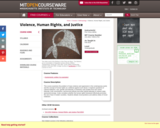
This course examines the problem of mass violence and oppression in the contemporary world, and the concept of human rights as a defense against such abuse. It explores questions of cultural relativism, race, gender and ethnicity. It examines case studies from war crimes tribunals, truth commissions, anti-terrorist policies and other judicial attempts to redress state-sponsored wrongs. It also considers whether the human rights framework effectively promotes the rule of law in modern societies. Students debate moral positions and address ideas of moral relativism.